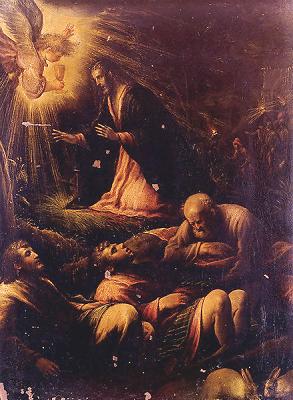Francesco Bassano
Italian, 1549-1592THE AGONY IN THE GARDEN
SN 89, oil on canvas
From "The Pages"
ARTIST:
The Bassanos were a family of painters. The grandfather, Francesco Bassano the Elder, was
an artist in the village of Bassano. His son, Jacopo Bassano, was one of the leading
Venetian artists of the 16th century. He, in turn, had four painter sons, the eldest being
Francesco da Ponte, called “Francesco Bassano the Younger.” He was trained in
his father’s workshop in Bassano between 1560-1570. Francesco’s precocious
talent was evident in 1566-67 with the work “Miracle of the Quails”.
During the 1570’s, he worked with his father on large altarpieces. At this time, he
devoted himself to rustic biblical paintings. Characteristics of these paintings are color
sprinkled with light and the tendency toward more descriptive realism.
In 1579, Francesco moved from Bassano to Venice. During the next years, he painted
nocturnal scenes illuminated by candle, torch, and flare, by moonlight and divine light -
nativities, adorations of the shepherds, and passion scenes culminating in the altarpiece
for Sant Afra in Brescia. He competed with Tintoretto, Veronese, and Palma Giovane, and
was awarded several commissions in the Sala del Scrutinio and the Sala del Maggiore
Consiglio of the Doge’s Palace. |
|
 |
At the height of his success, a mental illness became more acute and he threw himself
from an upper story window. He died several months later of complications from the
injuries suffered in that fall.
SUBJECT:
The painting illustrates the text in Luke (22:41-44) “And he withdrew from them about
a stone’s throw, and knelt down and prayed. ‘Father if thou art willing, remove
this cup from me; nevertheless not my will, but thine, be done.’ And there appeared
to him an angel from heaven, strengthening him. And being in an agony he prayed more
earnestly; and his sweat became like great drops of blood falling down upon the
ground.” The scene includes an angel appearing to Christ in answer to his call for
divine assistance; Christ is accepting the chalice from the hands of the angel, while
below Peter, James, and John sleep unaware - and Judas approaches with the soldiers to
arrest Christ.
PAINTING:
Altho’ this subject was often treated by painters of the 16th century, who found it
exceptionally suited to dramatic interpretation, never had the scene been presented as a
nocturnal one.
The painting is a vertical night scene with the praying Christ in the center of the
painting, and the Angel with the Chalice above Christ to the right. Bassano pierces the
darkness with rays of light issuing from the glowing Chalice to isolate the principal
figures. The chalice itself Christ’s approach to death.
A mysterious phosphorescence accents the clothing, foliage, and grass. The areas of lesser
light include the three disciples sleeping in the foreground of the scene, and the
soldiers to the left of Christ, perceived as in the background. Only their helmets catch a
glint of light. The figures within the painting, while realistic, do not involve the
viewer. Inspired by the freely-painted late works of Tintoretto, its Mannerist
implications make the transition from the Venetian High Renaissance to El Greco.
This painting is one of nine altarpieces showing the Passion of Christ that Francesco and
his family painted for the church of Sant’ Antonio in Brescia. It hung on the left of
the choir of S. Antonio, & is considered one of the greatest achievements of Bassano.
HISTORIC CONTEXT:
Venice, the “Pearl of the Adriatic,” is a cluster of islands at the head of the
Adriatic Sea that was approachable only by water until the middle of the nineteenth
century, when a causeway was constructed. In the 15th century Venice expanded her
territory into the mainland; these lands were called Terrafirma, and included the town of
Bassano - a source of food supply for Venice. By the end of the 15th century, trading
activities and immigration to Venice had produced one of the most heterogeneous
populations in Europe.
Four significant circumstances made an impact upon the evolution of Venice: its singular
setting, its tenacious Byzantine heritage, success as a vast trading empire, and its
cohesive political and social structure that was cosmopolitan in character.
During the period of Counter Reformation in the 1500’s, the Council of Trent began,
the Inquisition was established, Ignatius Loyola founded the Jesuit order, Michelangelo
took over the rebuilding of Saint Peters, and Phillip II was the king of Spain and ruler
of Netherlands, Americas, Milan, Burgundy, Naples, and Sicily.
Additional Bibliography:
Brown, P.F. Art and Life in Renaissance Venice. Harry N. Abrams, NY, 1997.
Pignatti, T. and Donahue, K. The Golden Century of Venetian Painting. The Los Angeles Co.
Museum of
Art. Los Angeles, 1979.
ringlingdocents.org
|